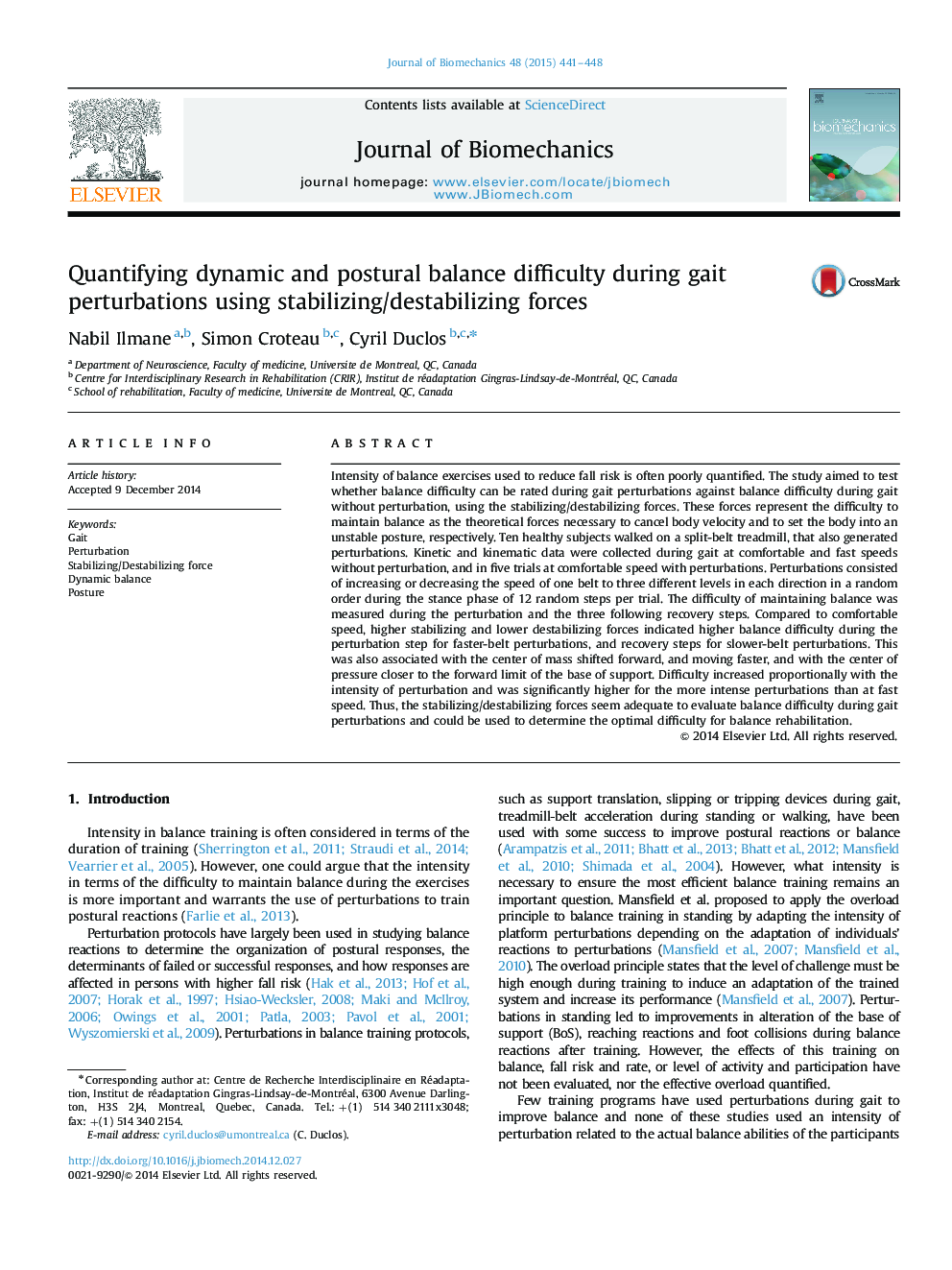| کد مقاله | کد نشریه | سال انتشار | مقاله انگلیسی | نسخه تمام متن |
|---|---|---|---|---|
| 10431211 | 910204 | 2015 | 8 صفحه PDF | دانلود رایگان |
عنوان انگلیسی مقاله ISI
Quantifying dynamic and postural balance difficulty during gait perturbations using stabilizing/destabilizing forces
ترجمه فارسی عنوان
کمبود تعادل دینامیکی و پوسیدگی در هنگام اختلالات راه رفتن با استفاده از نیروهای تثبیت کننده / بی ثبات کننده
دانلود مقاله + سفارش ترجمه
دانلود مقاله ISI انگلیسی
رایگان برای ایرانیان
کلمات کلیدی
راه رفتن، اختلال، تثبیت کننده / نیروی بی ثبات کننده، تعادل دینامیک، پوسیدگی،
ترجمه چکیده
شدت تمرینات تعادل که برای کاهش خطر سقوط استفاده می شود اغلب ضعیف است. این مطالعه با هدف بررسی اینکه آیا اختلالات قیمتی را می توان در هنگام بروز اختلالات قحطی در برابر مشکلات تعادل در هنگام قدم زدن بدون اختلال، با استفاده از نیروهای ثبات دهنده / بی ثبات کننده رتبه بندی کرد. این نیروها نشان دهنده دشواری برای حفظ تعادل به عنوان نیروهای نظری لازم برای لغو سرعت بدن است و به ترتیب بدن را به وضعیت ناپایدار تنظیم می کنند. ده افراد سالم روی یک تردمیل تسمه ای شکاری راه می رفتند، که باعث ایجاد اختلال شد. داده های جنبشی و سینماتیکی در طول راه رفتن در سرعت های راحت و سریع بدون وقفه، و در پنج آزمایش در سرعت راحت با اختلالات جمع آوری شد. اختلال ها شامل افزایش یا کاهش سرعت یک کمربند به سه سطح مختلف در هر جهت در یک فرایند تصادفی در طی مرحله ایست از 12 مرحله تصادفی در هر محاکمه بود. دشواری حفظ تعادل در طول اختلال و سه مرحله بعد بهبودی اندازه گیری شد. در مقایسه با سرعت راحت، نیروهای بی ثبات کننده با ثبات تر و پایین تر، در طی مرحله متلاشی شدن، مشکلات ترمز را برای ترمزهای کمربند سریعتر و مراحل بازیابی برای اختلال کمربند نشان داد. این نیز با مرکز جرم همراه بود به جلو، و حرکت سریع تر، و با مرکز فشار نزدیک به جلو جلو از پایه حمایت. دشواری افزایش با شدت آشفتگی افزایش یافته و به طور قابل توجهی بیشتر برای اختلالات شدیدتر از سرعت سریع بود. بنابراین، نیروهای تثبیتکننده / بی ثبات کننده به نظر میرسد برای ارزیابی تعادل مشکل در هنگام بروز اختلالات گمراه کافی است و میتواند برای تعیین مشکل بهینه برای بازتوانی تعادل استفاده شود.
موضوعات مرتبط
مهندسی و علوم پایه
سایر رشته های مهندسی
مهندسی پزشکی
چکیده انگلیسی
Intensity of balance exercises used to reduce fall risk is often poorly quantified. The study aimed to test whether balance difficulty can be rated during gait perturbations against balance difficulty during gait without perturbation, using the stabilizing/destabilizing forces. These forces represent the difficulty to maintain balance as the theoretical forces necessary to cancel body velocity and to set the body into an unstable posture, respectively. Ten healthy subjects walked on a split-belt treadmill, that also generated perturbations. Kinetic and kinematic data were collected during gait at comfortable and fast speeds without perturbation, and in five trials at comfortable speed with perturbations. Perturbations consisted of increasing or decreasing the speed of one belt to three different levels in each direction in a random order during the stance phase of 12 random steps per trial. The difficulty of maintaining balance was measured during the perturbation and the three following recovery steps. Compared to comfortable speed, higher stabilizing and lower destabilizing forces indicated higher balance difficulty during the perturbation step for faster-belt perturbations, and recovery steps for slower-belt perturbations. This was also associated with the center of mass shifted forward, and moving faster, and with the center of pressure closer to the forward limit of the base of support. Difficulty increased proportionally with the intensity of perturbation and was significantly higher for the more intense perturbations than at fast speed. Thus, the stabilizing/destabilizing forces seem adequate to evaluate balance difficulty during gait perturbations and could be used to determine the optimal difficulty for balance rehabilitation.
ناشر
Database: Elsevier - ScienceDirect (ساینس دایرکت)
Journal: Journal of Biomechanics - Volume 48, Issue 3, 5 February 2015, Pages 441-448
Journal: Journal of Biomechanics - Volume 48, Issue 3, 5 February 2015, Pages 441-448
نویسندگان
Nabil Ilmane, Simon Croteau, Cyril Duclos,
